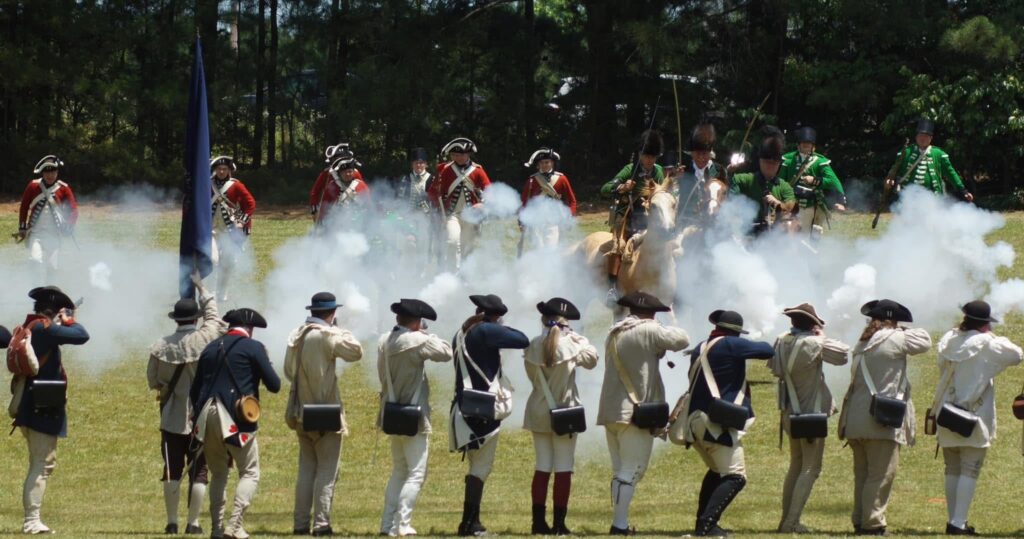
The Battle of the Waxhaws is a significant, yet often overlooked, event in the American Revolutionary War. Taking place on May 29, 1780, near the Waxhaw Settlement in present-day South Carolina, the battle had lasting consequences on the morale of the American colonists and the trajectory of the Southern Campaign. This brutal skirmish, sometimes known as the “Waxhaw Massacre,” is remembered not only for its military importance but also for the tragic loss of life and the notorious reputation it gave to British Lieutenant Colonel Banastre Tarleton.
In June 2024, the Museum of the Waxhaws brought history to life by hosting its inaugural Battle of the Waxhaws Reenactment Weekend. The event brought over 100 reenactors to the historic Waxhaw area, creating a vibrant and educational experience for visitors to connect with the past. The weekend was an immersive opportunity to witness the struggles and heroism of the 18th century, and a powerful reminder of the sacrifices made during the early days of the American Revolution.
The Battle of the Waxhaws: Context and Consequences
The Battle of the Waxhaws was a pivotal moment during the Southern Campaign of the American Revolutionary War. After the fall of Charleston, South Carolina, the British forces, under General Charles Cornwallis, turned their focus to quelling the growing patriot resistance in the southern colonies. Lieutenant Colonel Banastre Tarleton, a notorious and aggressive officer, led his cavalry in pursuit of a Continental force commanded by Colonel Abraham Buford.
Tarleton’s troops caught up with Buford’s forces, which were retreating from a previous battle. The American forces, which were largely untrained militia, attempted to surrender after realizing they were outmatched. However, Tarleton’s men, in a bloody act of vengeance, ruthlessly attacked the surrendered men, killing many while they were still attempting to surrender or after they had already yielded. The event became infamous, with many American patriots calling it a “massacre.” The brutality of the encounter would make Tarleton one of the most hated British officers in the colonies.
This act of violence played a crucial role in galvanizing American support for the Revolutionary cause, with the battle serving as a rallying cry for resistance. The massacre would fuel the patriot’s desire for vengeance and inspire future militia leaders like Francis Marion (the “Swamp Fox”) and Thomas Sumter to fight back against British forces in the Carolinas.
The Museum of the Waxhaws and the 2024 Reenactment Weekend
Fast forward to June 2024, and the Museum of the Waxhaws, a local institution dedicated to preserving the region’s rich history, hosted the inaugural Battle of the Waxhaws Reenactment Weekend. The event was a huge success, attracting history enthusiasts, families, and reenactors from across the country to this historic site.
Over 100 reenactors participated in the weekend’s activities, recreating the atmosphere and the dramatic moments of the Battle of the Waxhaws. Visitors to the museum had the unique opportunity to watch the reenactment of this fierce battle, which was both visually stunning and educational. From the soldiers’ period-accurate uniforms to the cannon fire and musket shots echoing through the air, the reenactment provided a window into the 18th century.
But the event wasn’t just about recreating the battle. It was a celebration of the culture and history of the time. Throughout the weekend, reenactors and historical interpreters shared knowledge about life during the Revolutionary War, including demonstrations of 18th-century cooking, blacksmithing, and military drills. Visitors were also able to tour the museum’s exhibits, which include artifacts, historical documents, and educational displays about the battle and the Waxhaw settlement.
The reenactment also had a deeper educational purpose. It was a reminder of the sacrifices made by ordinary people who fought for their independence and of the complexities of war—especially during the early days of the American Revolution. The brutality of the battle and its aftermath are not just military facts; they are part of the larger story of how the United States was forged in the fires of conflict.
A Weekend of Living History
The Battle of the Waxhaws Reenactment Weekend was a true living history experience. It offered visitors the rare opportunity to step back in time and experience what it was like to be a part of that crucial period in American history. The reenactors, dressed in period-accurate uniforms and using reproduction weapons and tools, provided an authentic atmosphere that was both informative and engaging.
Beyond the reenactments, the weekend offered an array of activities for all ages. Children and families could participate in historical crafts and games, while history buffs could engage in deeper discussions with reenactors and historians about the significance of the battle and the larger Southern Campaign. The weekend also included special educational programs, storytelling sessions, and guided tours of the Waxhaw Settlement area, which helped paint a fuller picture of the lives of those who lived through the revolution.
The Legacy of the Battle of the Waxhaws
The Battle of the Waxhaws, though small in scale compared to other Revolutionary War battles, is a powerful symbol of the sacrifices and resilience of the American patriots. The brutality of the battle highlighted the personal costs of the war and the deep animosity between the British and American forces. Over the years, the battle has grown in historical significance, becoming a defining moment in the story of the Southern Revolution.
The 2024 reenactment hosted by the Museum of the Waxhaws was an important event that ensured the legacy of the battle continues to be shared with future generations. It allowed people to connect with history in a meaningful way, offering both a poignant reminder of the past and a celebration of the resilience that led to the birth of a new nation.
As the event concluded, visitors left the Waxhaws with a renewed appreciation for the history of the American Revolution and the sacrifices made by those who fought for the freedom we enjoy today. The Museum of the Waxhaws has certainly established a strong foundation for future reenactments, ensuring that the history of the Battle of the Waxhaws—and its role in American independence—will continue to be remembered for years to come.
For those interested in experiencing history firsthand, the Battle of the Waxhaws Reenactment Weekend will surely become a must-see event in the future, drawing even more attention to this crucial, yet often overlooked, chapter in American history.
